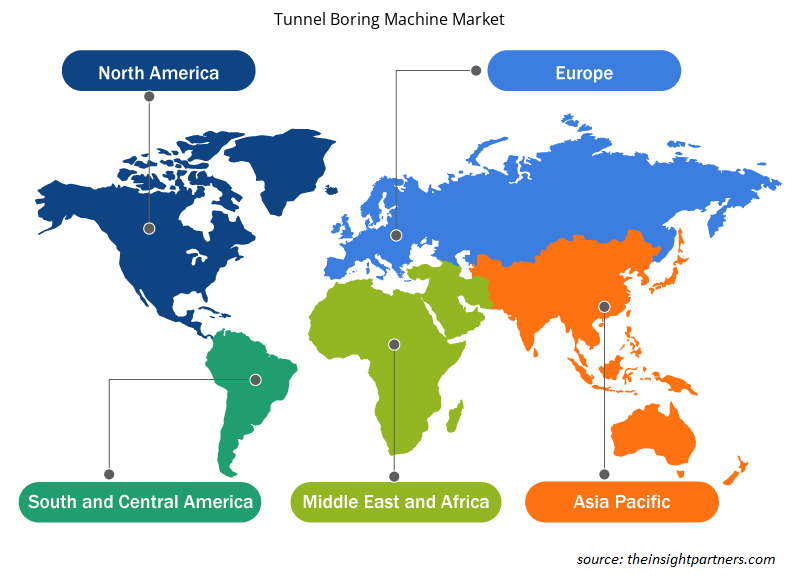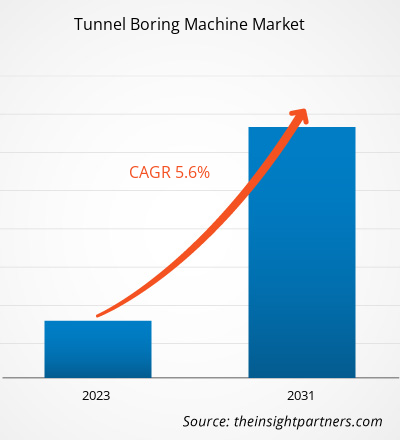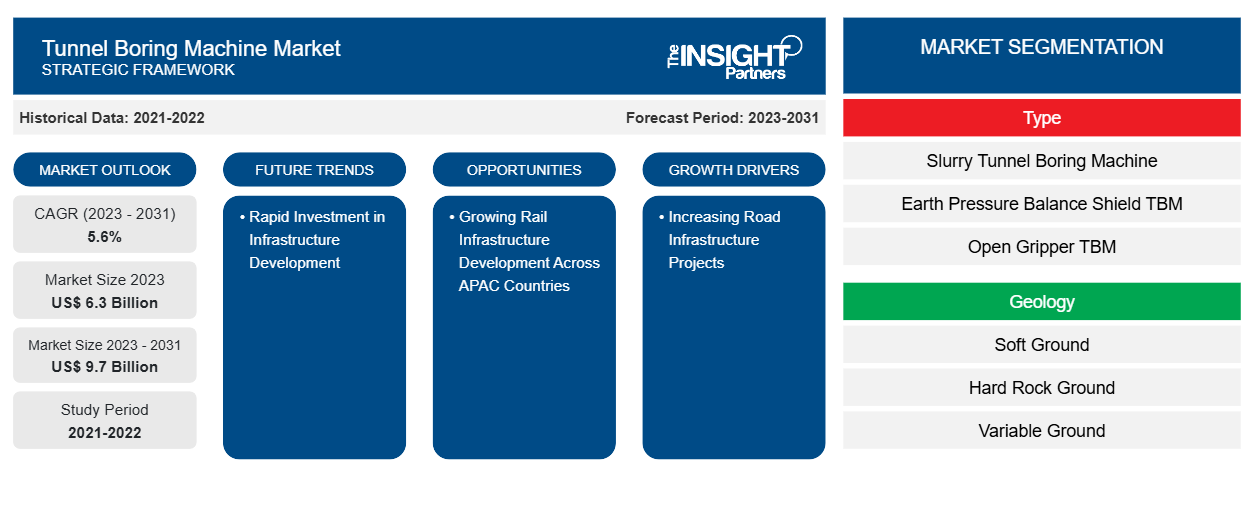Si prevede che il mercato delle macchine per la perforazione di tunnel raggiungerà i 9,7 miliardi di dollari entro il 2031, rispetto ai 6,3 miliardi di dollari del 2023. Si prevede che il mercato delle macchine per la perforazione di tunnel registrerà un tasso di crescita del 5,6% nel periodo 2023-2031. L'aumento dei progetti di infrastrutture stradali, l'attenzione crescente verso il micro-tunneling e il progresso tecnologico attraverso l'automazione e la tecnologia di taglio delle rocce sono tra i fattori chiave che guidano il mercato delle macchine per la perforazione di tunnel.
Analisi di mercato delle macchine perforatrici per tunnel
Si prevede che il mercato delle macchine per la perforazione di tunnel registrerà una crescita considerevole durante il periodo di tempo analizzato a causa del crescente numero di progetti di costruzione e dell'aumento degli investimenti verso lo sviluppo delle infrastrutture nelle economie in via di sviluppo e sviluppate in tutto il mondo. Inoltre, si prevede che la crescita delle industrie metallurgiche e minerarie e petrolifere e del gas in tutto il mondo aumenterà la domanda di macchine per la perforazione di tunnel per l'esplorazione di pozzi. Inoltre, le macchine per la perforazione di tunnel vengono sempre più impiegate nei cantieri per scavare tunnel in aree collinari o, nel caso di costruzioni sotterranee.timeframe owing to the rising number of construction projects as well as the rise in investment toward infrastructure development in developing and developed economies across the globe. Additionally, the growth of metals & mining and oil & gas industries across the globe is expected to raise the demand for tunnel boring machines for the exploration of wells. Moreover, tunnel boring machines are being increasingly deployed at construction sites to excavate tunnels in hilly areas or, in the case of underground construction.
Panoramica del mercato delle macchine perforatrici per tunnel
Le macchine per la perforazione di tunnel sono impiegate in diversi settori importanti, come petrolio e gas, sviluppo infrastrutturale e metalli e estrazione mineraria. L'applicazione di successo di questa macchina dipende dalla selezione di attrezzature e utensili da taglio adatti alle condizioni del terreno da incontrare. La crescita delle infrastrutture stradali è uno dei fattori significativi che spingono il mercato. Si prevede che l'aumento degli investimenti governativi nei progetti ferroviari guiderà il mercato globale delle macchine per la perforazione di tunnel. Ad esempio, a gennaio 2021, è iniziata in Danimarca la costruzione del tunnel del Fehmarnbelt tra Danimarca e Germania. Il progetto sarà completato entro il 2029. Il progetto consentirebbe lo sviluppo del più lungo tunnel combinato immerso in strada e rotaia in tutto il mondo. A giugno 2019, China Railway Engineering Equipment Group Co., Ltd. ha introdotto la sua macchina per la perforazione di tunnel, che è stata esportata in Italia per un progetto ferroviario che collega Milano e Verona. La macchina ha un diametro di 10,03 metri e una lunghezza di 155 metri; pesa 1.800 tonnellate. Si prevede che i crescenti livelli di industrializzazione e urbanizzazione nelle economie in via di sviluppo dovuti alla crescita demografica, uniti ai miglioramenti delle infrastrutture dei tunnel e all'aumento delle normative sulla sicurezza dei tunnel, stimoleranno ulteriormente la crescita del mercato delle macchine perforatrici per tunnel a livello globale durante il periodo di previsione.
Personalizza questo report in base alle tue esigenze
Riceverai la personalizzazione gratuita di qualsiasi report, comprese parti di questo report, o analisi a livello nazionale, pacchetto dati Excel, oltre a usufruire di grandi offerte e sconti per start-up e università
-
Scopri le principali tendenze di mercato in questo rapporto.Questo campione GRATUITO includerà analisi di dati che spaziano dalle tendenze di mercato alle stime e alle previsioni.
Driver e opportunità di mercato per le macchine perforatrici per tunnel
Aumento dei progetti di infrastrutture stradali
L'industria globale delle infrastrutture e delle costruzioni stradali sta crescendo a un ritmo significativo a causa dell'aumento della popolazione e dei livelli di urbanizzazione. Un aumento della spesa pubblica per le infrastrutture e la crescente estensione della rete stradale in tutti i paesi stanno guidando il mercato globale. La spesa per la costruzione e l'edificazione di nuove infrastrutture di trasporto in vari paesi potenziali e l'ammodernamento delle infrastrutture esistenti sta alimentando la domanda di macchine perforatrici per tunnel. Le attività di ammodernamento delle infrastrutture, lo sviluppo di città intelligenti e la crescente tendenza all'automazione dei tunnel sono alcuni dei principali fattori che alimentano il mercato globale. Diversi governi dei principali paesi sono coinvolti nella progettazione di tunnel per un trasporto stradale fluido e tempi di percorrenza ridotti.
- Nel maggio 2023, il President's Fiscal Year 2024 Appropriations Plan ha aggiunto il Gateway Hudson River Tunnel Project all'elenco dei progetti raccomandati per il finanziamento CIG in base all'aspettativa del completamento di tutti i passaggi necessari nella fase di progettazione. Sarà pronto per ricevere un accordo di sovvenzione di finanziamento completo nell'anno fiscale 2024.
- Negli ultimi anni, il governo indiano ha annunciato diversi progetti infrastrutturali finanziati dal governo. Questi progetti includono il Bharatmala Pariyojana, il Narmada Valley Development Project, il Chenab River Railway Bridge, il Delhi Metro Industrial Corridor, il Mumbai Trans Harbor Link, l'Inland Waterways Development Project, il Navi Mumbai International Project e il Zoji-la and Z-Morh Tunnel Project. Questi progetti mirano a modernizzare le infrastrutture dell'India e a migliorare la qualità della vita dei suoi cittadini.
Crescente sviluppo delle infrastrutture ferroviarie nell'area APAC
I tunnel sono sempre più utilizzati per il trasporto ferroviario nelle metropolitane e nelle metropolitane in vari paesi dell'APAC. La corretta costruzione, gestione e manutenzione dei sistemi di tunnel implica il monitoraggio di parametri chiave, come ventilazione, segnalazione, illuminazione, concentrazione di gas, temperatura, velocità e direzione dell'aria e risposta alle emergenze. Le economie sviluppate e le economie emergenti stanno vivendo una crescita nel settore ferroviario. Pertanto, si prevede che la necessità di macchine perforatrici di tunnel nell'APAC aumenterà. I governi di tutta la regione stanno investendo sempre di più nello sviluppo di infrastrutture ferroviarie che comprendono vari tunnel nel percorso e sono ben equipaggiate con dispositivi intelligenti.
Ad esempio, una macchina perforatrice per tunnel con una testa di taglio larga 13,1 metri è stata utilizzata per scavare il primo tunnel ferroviario sottomarino dell'India come parte del progetto del treno proiettile Mumbai-Ahmedabad. In precedenza, la più grande TBM dispiegata nel paese era larga 12,2 metri ed era utilizzata per scavare tunnel per il progetto della strada costiera di Mumbai. Pertanto, il crescente numero di progetti ferroviari nelle economie sviluppate e in via di sviluppo e i crescenti investimenti nello sviluppo di nuove infrastrutture sono alcuni dei fattori chiave che si prevede offriranno ampie opportunità di crescita ai principali attori che operano nel mercato globale delle macchine perforatrici per tunnel.
Analisi della segmentazione del rapporto di mercato delle macchine perforatrici per tunnel
I segmenti chiave che hanno contribuito alla derivazione dell'analisi di mercato delle macchine perforatrici di tunnel sono tipologia, geologia e utente finale.
- In base al tipo, il mercato delle macchine per la perforazione di tunnel è suddiviso in TBM a fanghi, TBM a scudo con bilanciamento della pressione della terra, TBM a pinza aperta, TBM schermate, TBM multimodali e altre. Il segmento delle TBM a fanghi ha detenuto la quota di mercato maggiore nel 2023.
- In termini di geologia, il mercato delle macchine per la perforazione di tunnel è segmentato in terreno soffice, terreno roccioso duro e terreno variabile. Il segmento del terreno soffice ha detenuto la quota di mercato maggiore nel 2023.
- In base all'utente finale, il mercato è stato segmentato in trasporti, metalli e miniere, petrolio e gas e altri. Il segmento dei trasporti ha dominato il mercato nel 2023.
Analisi della quota di mercato delle macchine perforatrici per area geografica
L'ambito geografico del rapporto sul mercato delle macchine perforatrici di tunnel è suddiviso principalmente in cinque regioni: Nord America, Europa, Asia Pacifico, Medio Oriente e Africa, Sud e Centro America.
L'Asia Pacifica ha dominato il mercato delle macchine per la perforazione di tunnel nel 2023. Il mercato nell'Asia Pacifica è segmentato in Australia, Cina, India, Giappone, Corea del Sud e resto dell'Asia Pacifica. Si prevede che la crescita nella costruzione di strade, ferrovie e altre attività di sviluppo infrastrutturale andrà a vantaggio del mercato delle macchine per la perforazione di tunnel nell'Asia Pacifica. Nell'APAC, gli operatori del mercato stanno riscontrando un aumento della domanda per i loro prodotti a causa del costante sviluppo nei trasporti e nelle infrastrutture stradali e ferroviarie. Cina e Giappone sono le principali economie nel mercato delle macchine per la perforazione di tunnel nell'APAC. In India, Delhi Metro Rail Corporation offre una rete Mass Rapid Transportation System (MRTS) per la città di Delhi. La rete MRTS è un mix di a livello, sopraelevata e sotterranea. Per l'infrastruttura della rete sotterranea, i tunnel sono stati costruiti da macchine a scudo di tipo fanghi. Nella fase successiva del progetto, la stazione ferroviaria utilizzerà circa 14 macchine per la perforazione di tunnel per costruire un tunnel con un diametro di 5,8 metri.
Approfondimenti regionali sul mercato delle macchine perforatrici per tunnel
Le tendenze regionali e i fattori che influenzano il mercato delle macchine per perforazione di tunnel durante il periodo di previsione sono stati ampiamente spiegati dagli analisti di Insight Partners. Questa sezione discute anche i segmenti e la geografia del mercato delle macchine per perforazione di tunnel in Nord America, Europa, Asia Pacifico, Medio Oriente e Africa e Sud e Centro America.

- Ottieni i dati specifici regionali per il mercato delle macchine perforatrici per tunnel
Ambito del rapporto di mercato delle macchine perforatrici per tunnel
| Attributo del report | Dettagli |
|---|---|
| Dimensioni del mercato nel 2023 | 6,3 miliardi di dollari USA |
| Dimensioni del mercato entro il 2031 | 9,7 miliardi di dollari USA |
| CAGR globale (2023-2031) | 5,6% |
| Dati storici | 2021-2022 |
| Periodo di previsione | 2023-2031 |
| Segmenti coperti |
Per tipo
|
| Regioni e Paesi coperti |
America del Nord
|
| Leader di mercato e profili aziendali chiave |
|
Densità dei giocatori del mercato delle macchine perforatrici per tunnel: comprendere il suo impatto sulle dinamiche aziendali
Il mercato delle Tunnel Boring Machine sta crescendo rapidamente, spinto dalla crescente domanda degli utenti finali dovuta a fattori quali l'evoluzione delle preferenze dei consumatori, i progressi tecnologici e una maggiore consapevolezza dei vantaggi del prodotto. Con l'aumento della domanda, le aziende stanno ampliando le loro offerte, innovando per soddisfare le esigenze dei consumatori e capitalizzando sulle tendenze emergenti, il che alimenta ulteriormente la crescita del mercato.
La densità degli operatori di mercato si riferisce alla distribuzione di aziende o società che operano in un particolare mercato o settore. Indica quanti concorrenti (operatori di mercato) sono presenti in un dato spazio di mercato in relazione alle sue dimensioni o al valore di mercato totale.
Le principali aziende che operano nel mercato delle macchine perforatrici per tunnel sono:
- Società per la costruzione di ferrovie cinesi Heavy Industries Ltd.
- Kawasaki Heavy Industries Ltd
- CREG TBM Germania GmbH
- Terratec Ltd
- Azienda Agricola Herrenknecht
- Società Hitachi Zosen
Disclaimer : le aziende elencate sopra non sono classificate secondo un ordine particolare.

- Ottieni una panoramica dei principali attori del mercato delle macchine perforatrici per tunnel
Notizie di mercato e sviluppi recenti sulle macchine perforatrici per tunnel
Il mercato delle macchine per la perforazione di tunnel viene valutato raccogliendo dati qualitativi e quantitativi dopo la ricerca primaria e secondaria, che include importanti pubblicazioni aziendali, dati associativi e database. Di seguito sono elencati alcuni degli sviluppi nel mercato delle macchine per la perforazione di tunnel:
- Nel novembre 2023, la Valley Transportation Authority ha acquistato una macchina perforatrice per tunnel da Herrenknecht per il suo progetto BART Silicon Valley Phase II. Questa strategia ha aumentato la base clienti di Herrenknecht e rafforzato la posizione dell'azienda in questo mercato.
- Ad agosto 2020, la più grande macchina perforatrice per tunnel della Herrenknecht AG mai utilizzata in Europa ha completato la sua corsa a giugno. La trivella di grandi dimensioni (Earth Pressure Balance Shield, diametro 15,87 metri) è stata prodotta dalla Herrenknecht.
Copertura e risultati del rapporto di mercato sulle macchine perforatrici per tunnel
Il rapporto "Dimensioni e previsioni del mercato delle macchine per perforazione di gallerie (2021-2031)" fornisce un'analisi dettagliata del mercato che copre le seguenti aree:
- Dimensioni e previsioni del mercato delle macchine perforatrici per tunnel a livello globale, regionale e nazionale per tutti i principali segmenti di mercato coperti dall'ambito
- Tendenze del mercato delle macchine perforatrici per tunnel e dinamiche di mercato come driver, vincoli e opportunità chiave
- Analisi dettagliata delle cinque forze PEST/Porter e SWOT
- Analisi di mercato delle macchine perforatrici per tunnel che copre le principali tendenze del mercato, il quadro globale e regionale, i principali attori, le normative e i recenti sviluppi del mercato
- Analisi del panorama industriale e della concorrenza che copre la concentrazione del mercato, l'analisi della mappa di calore, i principali attori e gli sviluppi recenti per il mercato delle macchine perforatrici per tunnel
- Profili aziendali dettagliati
- Analisi storica (2 anni), anno base, previsione (7 anni) con CAGR
- Analisi PEST e SWOT
- Valore/volume delle dimensioni del mercato - Globale, Regionale, Nazionale
- Industria e panorama competitivo
- Set di dati Excel
Report recenti
Rapporti correlati
Testimonianze
Motivo dell'acquisto
- Processo decisionale informato
- Comprensione delle dinamiche di mercato
- Analisi competitiva
- Analisi dei clienti
- Previsioni di mercato
- Mitigazione del rischio
- Pianificazione strategica
- Giustificazione degli investimenti
- Identificazione dei mercati emergenti
- Miglioramento delle strategie di marketing
- Aumento dell'efficienza operativa
- Allineamento alle tendenze normative























 Ottieni un campione gratuito per - Mercato delle macchine perforatrici per gallerie
Ottieni un campione gratuito per - Mercato delle macchine perforatrici per gallerie